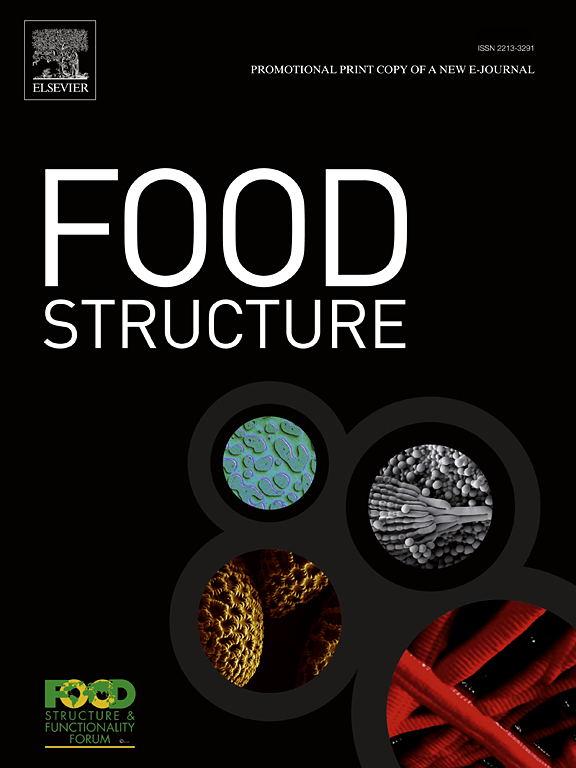Insights into the mechanical and simulated oral processing behaviors of gelatin-κ-carrageenan hydrogels reinforced by sorbitol replacement
IF 5.9
3区 农林科学
Q1 FOOD SCIENCE & TECHNOLOGY
引用次数: 0
Abstract
Gelatin-based hydrogels are extensively employed in the food industry, and their mechanical properties and oral perception attributes play essential roles in the applications. In this study, we presented a type of mechanically robust gelatin-carrageenan (KC) hydrogels reinforced by sorbitol replacement. FTIR spectra and T2 relaxation time analysis revealed that KC addition and sorbitol replacement promoted the formation of intermolecular hydrogen bonds, resulting in denser gel network structures. After KC addition and sorbitol replacement, hydrogels exhibited significantly improved mechanical properties, including higher hardness (from 1.54 ± 0.14 N to 15.64 ± 0.85 N) and storage modulus, greatly outperforming conventional gelatin-carrageenan hydrogels. Additionally, KC addition and sorbitol replacement changed the simulated oral processing behaviors of these hydrogels. The oral thermal stability of the gels was improved and the apparent viscosity (η) was enhanced. In LAOS tests, for all the gels, storage modulus/critical modulus (G′/G′0) was reduced, and loss modulus/critical modulus (G″/G″0) was first increased and then decreased. In tribological tests, sorbitol replacement increased the friction coefficient (μ) and prolonged the boundary region. Importantly, the gels with higher shear viscosity had lower friction coefficients (1.5 %KG-AR). The above findings offered valuable insights for developing mechanically stronger food gels with favorable textural properties.
山梨醇替代增强明胶-κ-卡拉胶水凝胶的力学和模拟口腔加工行为的研究
明胶基水凝胶广泛应用于食品工业,其力学性能和口腔感知特性在应用中起着至关重要的作用。在这项研究中,我们提出了一种机械坚固的明胶-卡拉胶(KC)水凝胶由山梨醇替代增强。FTIR光谱和T2弛豫时间分析表明,KC加成和山梨醇取代促进了分子间氢键的形成,导致凝胶网络结构更加致密。添加KC和替代山梨醇后,水凝胶的力学性能得到了显著改善,硬度(从1.54 ± 0.14 N提高到15.64 ± 0.85 N)和储存模量大大优于传统明胶-卡拉胶水凝胶。此外,KC的加入和山梨醇的替代改变了这些水凝胶的模拟口腔加工行为。改善了凝胶的口服热稳定性,提高了表观粘度(η)。在LAOS试验中,所有凝胶的储存模量/临界模量(G′/G′0)均降低,损失模量/临界模量(G″/G″0)先升高后降低。在摩擦学试验中,山梨醇替代增加了摩擦系数(μ),延长了边界区域。重要的是,具有较高剪切粘度的凝胶具有较低的摩擦系数(1.5 %KG-AR)。上述发现为开发具有良好结构性能的机械强度较高的食品凝胶提供了有价值的见解。
本文章由计算机程序翻译,如有差异,请以英文原文为准。
求助全文
约1分钟内获得全文
求助全文
来源期刊

Food Structure-Netherlands
Chemical Engineering-Bioengineering
CiteScore
7.20
自引率
0.00%
发文量
48
期刊介绍:
Food Structure is the premier international forum devoted to the publication of high-quality original research on food structure. The focus of this journal is on food structure in the context of its relationship with molecular composition, processing and macroscopic properties (e.g., shelf stability, sensory properties, etc.). Manuscripts that only report qualitative findings and micrographs and that lack sound hypothesis-driven, quantitative structure-function research are not accepted. Significance of the research findings for the food science community and/or industry must also be highlighted.
 求助内容:
求助内容: 应助结果提醒方式:
应助结果提醒方式:


